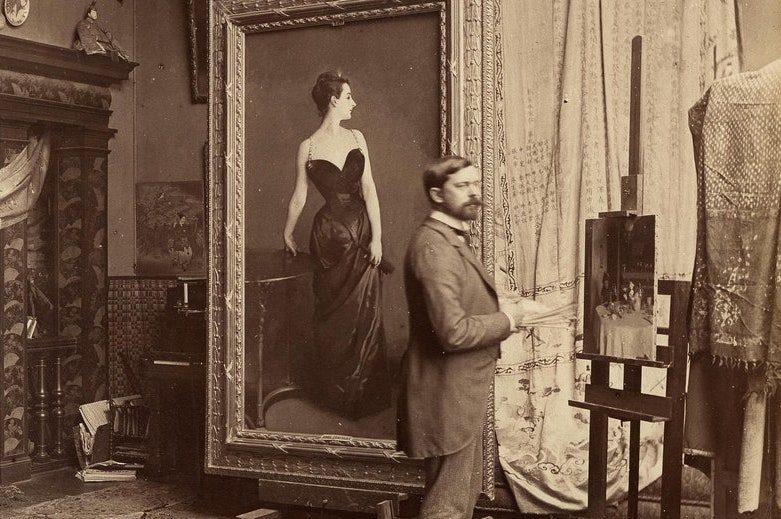
1. Multiple Countries Can Claim Sargent as Their Own
John Singer Sargent was born in Florence, Italy, to American expatriate parents who had left Philadelphia to mourn the loss of their first-born child. He grew up all over western Europe in a semi-migratory existence and developed an interest in art during this unconventional childhood. He first studied painting in Florence before moving to Paris, then the undisputed capital of the art world. During his adult career, he spent significant periods in France (until he left due to the Madame X scandal), Britain (where he sought artistic refuge after said scandal), and the United States. Museums in the States categorize Sargent as an American artist, but European museums also own many of his works, especially portraits of their turn-of-the-century luminaries. He is one of the few pre-WWII American artists to be well-represented across the Atlantic.
2. His Love Life is a Giant Question Mark
Generally, we know a lot about the popular and well-liked Sargent, including his talent for music and socially-prominent friends, but one thing we can’t be sure of is his romantic inclinations. That’s because Sargent had no romantic partners that we know of. Rumors have certainly emerged about his relationships both with men and with women, but we still have no idea who those potential lovers might have been, and we have no solid evidence they actually existed. There aren’t even any good candidates among his close friends and associates. Sargent never married or had any children, but exactly why he chose to stay single remains a mystery for the moment.
3. He Studied at the Famous École des Beaux-Arts and Considered Himself an Academic Artist
With his family’s encouragement, eighteen-year-old Sargent moved to Paris to further his artistic training. His first teacher was French society portraitist Charles-Émile-Auguste Durand. Carolus-Duran, as he was better known, had a then-radical approach to portrait painting: he advised his students to paint directly onto their canvases without the help of the usual preparatory sketches or underdrawings. He also encouraged them to study the works of Old Master painters like Velazquez and Van Dyck. Much of Sargent’s fresh and energetic style comes from Carolus-Duran’s influence, and Sargent painted a memorable portrait of his mentor in 1879.
In addition to studying with Carolus-Duran, Sargent also enrolled at the prestigious École des Beaux-Arts. This venerable art school used a very traditional curriculum that relied heavily on careful preparation and sketching from the nude. Sargent clearly learned his lessons well and maintained a drawing practice throughout his career. During his time in Paris, he also exhibited regularly at the city’s famous Salons. This background and training led Sargent to consider himself a traditional academic painter, though we might perhaps read a touch of Impressionism in his bright colors and loose brushwork.
4. He Was a World Traveler
Sargent clearly inherited the wandering spirit from his parents, since he became an accomplished traveler himself, visiting places like Spain, North Africa, the Isle of Capri, and Venice. What’s more, he recorded all he saw in his art, especially in a substantial series of watercolors depicting the people and landmarks of the places he visited. They portray vivid scenes like Venetian architecture, Bedouins, Italian luxury gardens, stonecutters at work in marble quarries, Alpine vistas, and his family and friends relaxing in various European destinations. Colorful, energetic, and economical in their depictions, they feel more experimental than most of Sargent’s finished paintings. However, Sargent also made oil paintings based on his travels. For example, a recent exhibition in Washington focused on his images of Spain.
5. He Retired Early from Portrait Painting, then Made Some Grand Murals
Although he made his reputation as a society portrait painter, Sargent wasn’t all that happy in this role. This is understandable considering the demands of the job – the time and physical effort required and the headaches that came from dealing with wealthy and privileged patrons. So, Sargent retired from portrait painting in 1907. With only a few exceptions, he stuck to this decision for the remainder of his career and satisfied hopeful sitters with charcoal portraits instead. He used his newfound free time to travel and work on grand, allegorical murals in his American home base of Boston. The Boston Public Library’s The Triumph of Religion murals (in the historic McKim Building on Copley Square) and Sargent’s murals in the Museum of Fine Arts, Boston still survive today, as do his numerous preparatory sketches for both cycles. As you can see below, the murals are quite different in style, subject matter, and tone from the rest of his work. Mural painting largely occupied the last decades of Sargent’s life.
6. His Grand-Nephew is His Biggest Supporter
The most important John Singer Sargent scholar in the world is a British man named Richard Ormond, who has a special connection to his work. As the son of Sargent’s sister Violet, Ormond is the artist’s grand-nephew. Although the two men never met – Sargent died more than a decade before Ormond’s birth – Ormond has spent his career studying and championing his relative’s art. Along with a few other key Sargent scholars, Ormond has literally written the book(s) on John Singer Sargent. I was lucky enough to attend a talk he gave at the Morgan Library and Museum a few years ago, and it was especially cool to hear him mention his personal memories of a Sargent relative depicted in a portrait drawing.
